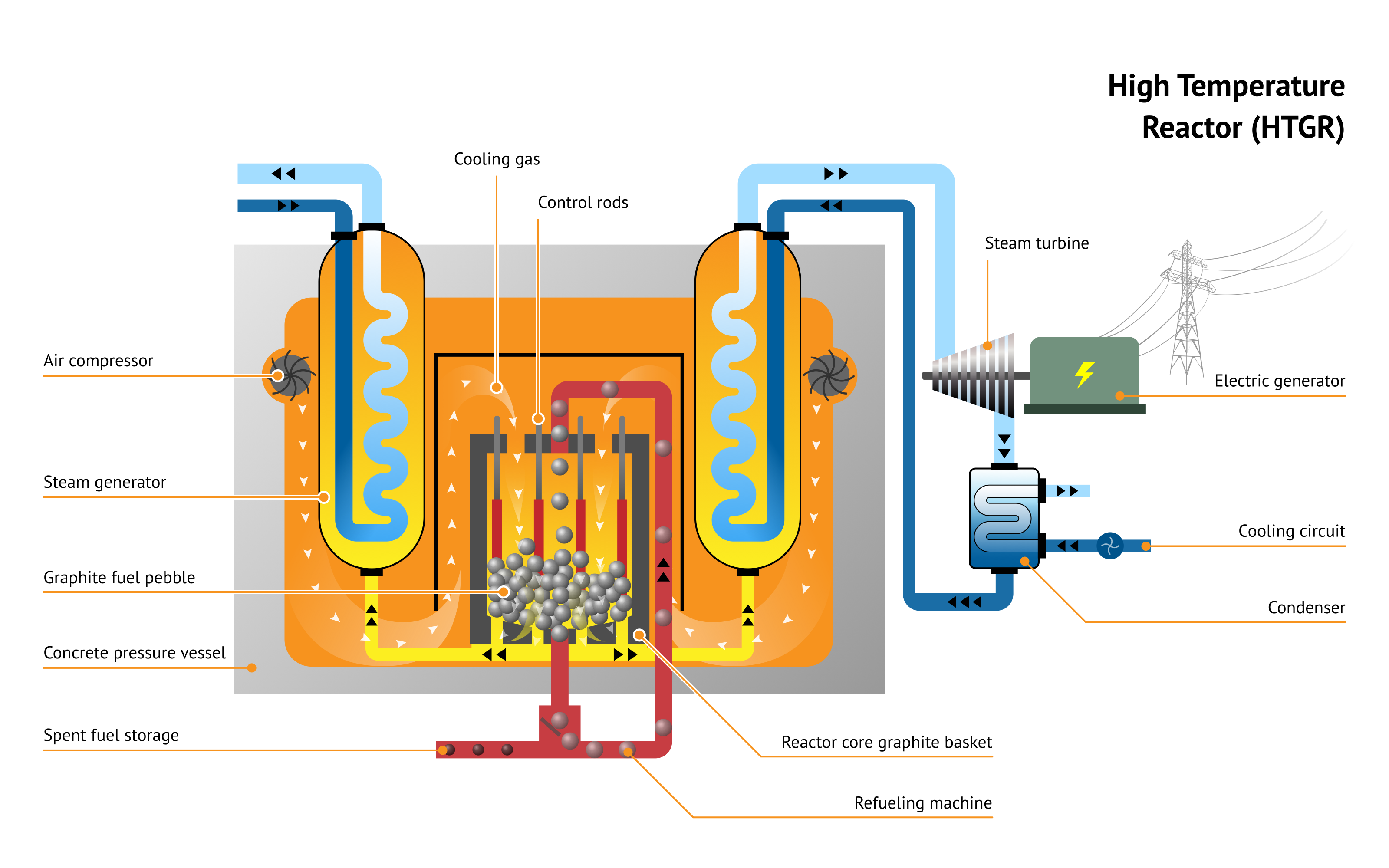Table of Contents
What is a High Temperature Gas Reactor?
As a Generation IV design and Advanced Modular Reactor, a High Temperature Gas Cooled Reactor (HTGR), also known as a Very High Temperature Reactor (VHTR), represents an exciting innovation in nuclear reactor design. Operating at significantly higher temperatures than traditional reactors, an HTGR offers enhanced efficiency and safety. The design is capable of serving multiple purposes, including power generation and co-production of hydrogen.
But, what is a High Temperature Gas Reactor (HTGR)? Picture scientists contemplating, “What if we ditched the usual water routine and cranked up the heat with super-hot gases to whip up some electricity?” This out-of-the-box notion has been percolating in the scientific community, catching the eye of enthusiasts.

Moderator
A gas-cooled fast reactor (GFR) uses the thermal neutron spectrum – neutrons with an average energy of 0.025 eV at room temperature. Therefore, a moderator is required.
In the case of an HTGR, this moderator is graphite – slowing down neutrons to the thermal spectrum, allowing them to be more easily absorbed by fissile nuclei and therefore sustain a chain reaction efficiently in the reactor’s fuel.
Gas Coolant
With a high temperature gas reactor operating at high temperatures (often reaching 750-1000 °C), the most common choice of coolant is inert helium gas.
TRISO Fuel
Due to the extremely high temperatures reached, overcoming challenges in fuel and material, performance is a key focus in high temperature gas reactor design and development. Thus, innovation has been required, and HTGRs use a new type of fuel: TRISO fuel, also known as tri-structural isotropic fuel.
TRISO fuel is multilayered, comprising uranium, plutonium or thorium oxide fuel kernels (pellets) enclosed in layers of carbon and silicon carbide. This provides additional containment and inherent safety, all whilst allowing the fuel to withstand the extremely high temperatures within the reactor.
A typical high temperature gas reactor contains billions of tiny TRISO particles, embedded either within a hexagonal block of graphite stacked within the reactor core (known as a prismatic reactor) or loosely dispersed graphite pebbles (known as a pebble bed reactor)

Development of High Temperature Gas Reactor Technology
History of the High Temperature Gas Reactor
The origins of the High Temperature Gas Reactor can be found in the mid-twentieth century. Early designs by the UK (the Dragon Reactor, Winfrith), the USA (Peach Bottom 1, Pennsylvania) and Germany (AVR, Jülich) led the way in the 1960s – demonstrating feasibility of the technology.
What sets HTGRs apart is their knack for reaching staggering temperatures, akin to a nuclear oven turning up the dial to unprecedented levels. It’s like tapping into the potency of scorching steam to fuel our electricity needs.
What is happening today?
Despite setbacks in the 1980s, the HTGR has begun a recent resurgence. Taking the lead in this heat-powered revolution are countries like China, the USA and Japan, pooling their resources to propel High Temperature Gas Reactor technology into uncharted territories.
Although HTGRs aren’t illuminating our homes just yet, researchers are constructing pint-sized prototypes to unravel the complexities of these high-temperature reactors. This includes the High Temperature Reactor – Pebble Bed Module (HTR-PM) in China, the world’s first commercial HTGR – connected to the electricity grid since 2023.
Explore Further
Choose from the articles below to continue learning about nuclear.
Advanced Modular Reactor (AMR) – The Future of Nuclear Energy Explained
Molten Salt Reactor (MSR) – The Future of Clean Energy?
High Temperature Gas Reactor (HTGR) – Innovation in Prisms & Pebbles
Gas-Cooled Fast Reactor (GFR) – High-Efficiency, Next-Gen Nuclear Power
Did you know? Explore Nuclear also offers great careers information and learning resources.
Below you can find references to the information and images used on this page.
